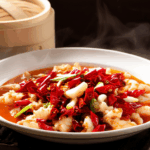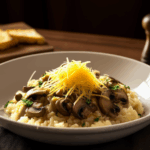Perfect Pasta Primavera for Your Dinner Table
Welcome to the world of culinary delights! Today, we are going to explore one of the most versatile and delicious dishes that can grace your dinner table – Pasta Primavera. This classic Italian dish is not only easy to prepare but also offers endless possibilities for customization. Whether you’re a seasoned chef or a beginner in the kitchen, this recipe will guide you through creating a perfect Pasta Primavera that will impress your family and friends.
Introduction to Pasta Primavera
Pasta Primavera, which translates to “spring pasta” in Italian, was originally created in the 1970s at Le Cirque restaurant in New York City. It was designed as a vegetarian alternative to traditional pasta dishes. Over the years, it has become a popular choice for those looking for a light yet satisfying meal. The dish typically features a variety of fresh vegetables tossed with al dente pasta in a simple sauce made from olive oil, garlic, and herbs. Its simplicity allows for creativity, making it a favorite among both chefs and home cooks alike.
Necessary Ingredients
- Pasta: Choose a high-quality pasta such as spaghetti, linguine, or penne. For an added touch, opt for whole wheat or gluten-free varieties if desired.
- Vegetables: Select a mix of colorful and seasonal vegetables like bell peppers, zucchini, cherry tomatoes, broccoli florets, and mushrooms. Feel free to experiment with different combinations based on availability and personal preference.
- Garlic: Fresh garlic cloves are essential for adding depth of flavor to the dish.
- Olive Oil: Extra virgin olive oil is recommended for its rich flavor and health benefits.
- Herbs: Fresh basil, parsley, and oregano add freshness and aroma to the dish. Dried versions may be used if fresh herbs are unavailable.
- Lemon Zest: A small amount of lemon zest provides a bright citrusy note that complements the vegetables beautifully.
- Cheese: Grated Parmesan cheese adds richness and creaminess to the dish. You can also use other cheeses like pecorino Romano for variation.
- Salt and Pepper: Seasoning is key to enhancing flavors in any dish.
Step-by-Step Instructions
- Prepare the Vegetables: Wash all the vegetables thoroughly under cold water. Trim and slice them into bite-sized pieces. Set aside.
- Boil the Pasta: Bring a large pot of salted water to a boil. Add the pasta and cook according to package instructions until al dente. Drain the pasta and set it aside.
- Sauté the Garlic: In a large skillet over medium heat, warm up about 3 tablespoons of olive oil. Add minced garlic and sauté for about 1 minute until fragrant but not browned.
- Stir-Fry the Vegetables: Increase the heat to high and add the prepared vegetables to the skillet. Stir-fry for about 5 minutes until they are tender-crisp. Be careful not to overcook the vegetables as they should retain their vibrant colors and crunch.
- Combine Pasta and Sauce: Return the cooked pasta to the skillet with the vegetables. Toss everything together until well combined.
- Add Finishing Touches: Drizzle additional olive oil over the pasta mixture if needed. Sprinkle in some chopped fresh herbs, grated Parmesan cheese, and a pinch of freshly ground black pepper. If using, grate some lemon zest over the top for extra brightness.
- Serve Immediately: Transfer the Pasta Primavera to serving plates and garnish with additional herbs or cheese if desired. Serve hot alongside a fresh salad or crusty bread for a complete meal.
Tips for Success
To ensure your Pasta Primavera turns out perfectly every time, consider these tips:
- Use fresh ingredients whenever possible. They make all the difference in taste and texture.
- Don’t overcrowd the pan when stir-frying the vegetables. Cook them in batches if necessary to maintain even cooking.
- Reserve some pasta water before draining. This starchy liquid can be added back into the sauce to help it coat the noodles better.
- Vary the types of pasta and vegetables seasonally to keep things interesting throughout the year.
Variations and Additions
Pasta Primavera is highly adaptable, allowing you to incorporate various proteins and spices to suit your tastes:
- Protein Options: For a more filling meal, consider adding grilled chicken breast, shrimp, tofu, or tempeh.
- Spice It Up: Experiment with different spices such as red pepper flakes, cumin, or smoked paprika for added depth of flavor.
- Asian Influence: Swap out traditional Italian herbs for Asian-inspired ones like ginger, cilantro, and soy sauce.
Conclusion
Pasta Primavera is not just another pasta dish; it’s a celebration of fresh, vibrant ingredients brought together in harmony. With its ease of preparation and endless potential for customization, it truly deserves a place at your dinner table. So why wait? Gather your favorite vegetables, choose your preferred pasta, and let your creativity flow as you prepare this delightful dish. Bon Appétit!


